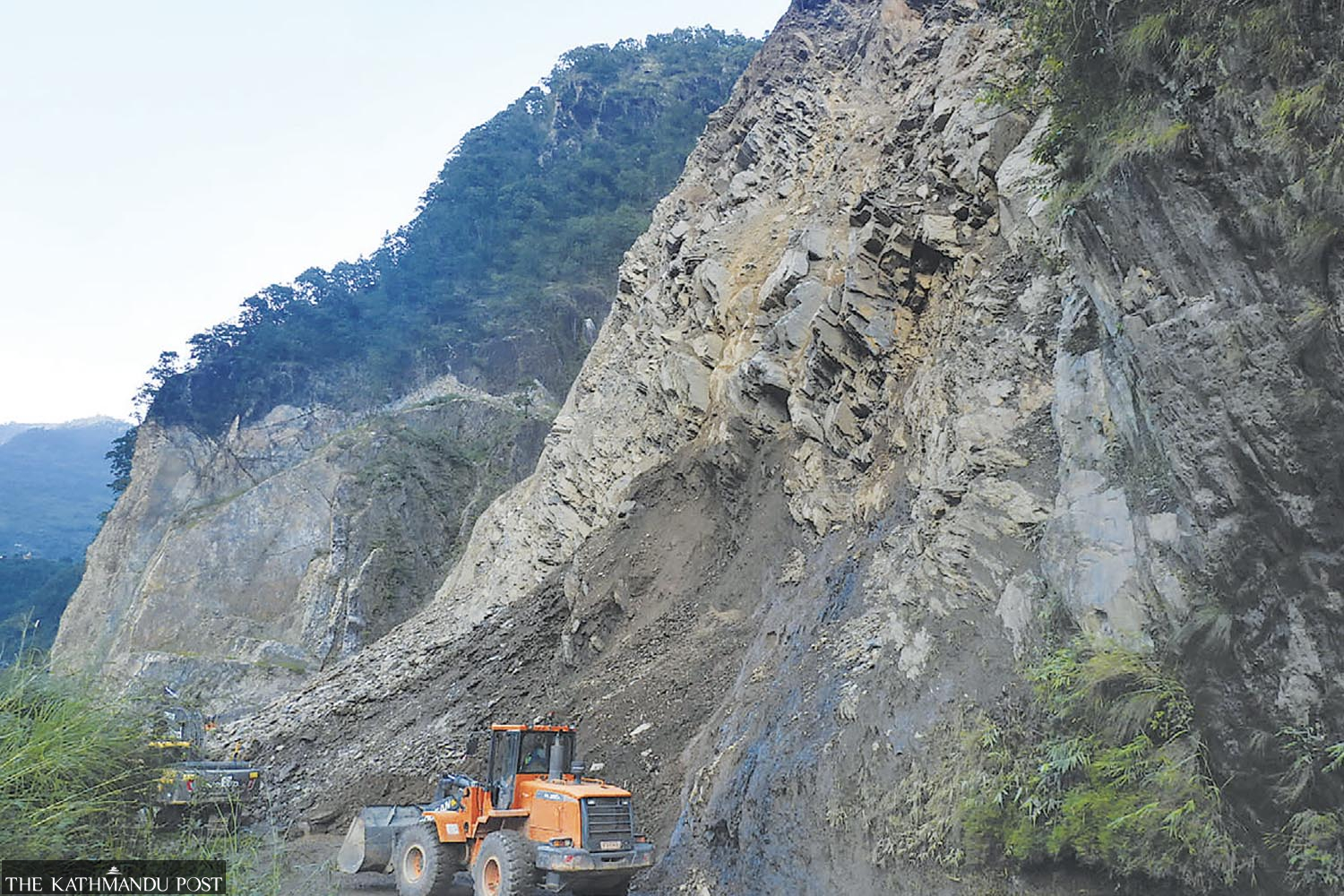National
Passengers endure two nights stranded on the road as Tuinkhola landslide blocks Narayanghat-Muglin section
Officials warn more landslides may block the Muglin-Narayanghat road section, and call for long-term fixes.
Ramesh Kumar Paudel
For Krishna Mahata, a government employee from Dillibazar, Kathmandu, and his wife Basanti, what began as a routine journey turned into an ordeal they will not soon forget. Boarding a bus in Dadeldhura on Thursday afternoon, they expected to reach Kathmandu by early Friday morning. Instead, their trip turned into a marathon of delays. By the time they reached Daunne in Nawalparasi, it was already five in the morning—and their bus was stuck in a long traffic jam. It took them until 5 pm on Friday just to reach Narayanghat.
Hoping to reach Kathmandu before dawn, they never made it to Muglin that day. As their bus neared the Tuinkhola bridge along the Muglin-Narayanghat road section, a massive landslide blocked the road about 2.5 kilometres from Muglin Bazar. They spent two nights on the road. With no food or water and the dark forest all around, they had no choice but to spend the night on the road. “It felt like we were in the middle of nowhere. We couldn’t leave the bus not knowing when the road would reopen,” Krishna recalled.
When daylight broke, he spotted some tea shops a little further away. Only then did they go and have some tea. The couple survived on tea, noodles, and drinking water distributed by the Chief District Officer’s team in Chitwan on Saturday afternoon.
A massive landslide struck near the Tuinkhola bridge at ward 5 of Ichchhakamana Rural Municipality in Chitwan, on Friday evening, following days of continuous rain. It blocked traffic along the country’s busiest highway, which connects Kathmandu with the East-West Highway and carries more than 10,000 vehicles on a daily basis, including passenger buses and freight trucks.
Even after clearance work began, Krishna feared they might have to spend a third night stranded. Luckily, the road reopened partially on Sunday afternoon, with vehicles taking turns to pass through the single-lane bottleneck.
But the sense of relief was overshadowed by warnings from experts about the growing risks along the Muglin-Narayanghat corridor. Narayan Prasad Lamichhane, chief of the Division Road Office in Bharatpur, said the landslide had left the entire hillside dangerously unstable. “The risk has increased. Permanent mitigation will require anchoring with rock netting, which is not immediately possible,” he explained, estimating costs at around Rs100 million.

According to Lamichhane, right after the Dashain festival [which is just over a week away], a team of experts from the Department of Roads will be called for a detailed study. Based on their findings, work is expected to begin this coming winter. Although a study on landslide prevention was conducted earlier, he explained that the landslide zone has now expanded and its nature has changed, making further study necessary. Previously, landslides with rocks and debris used to fall from about 70 metres above, but this time, according to Lamichhane, smaller and larger rock fragments have been falling from heights of 100 to 150 metres above the road, warranting more extensive research.
Landslides along this corridor are not new. After the road stretch was widened to two lanes in 2019, several sections became vulnerable to erosion and slope failures. The Tuinkhola bridge, completed last year, was one of 15 bridges constructed along the route to improve traffic flow. However, cutting into steep hillsides for these projects weakened slopes, triggering recurring landslides, mainly during monsoon seasons.
Two years ago, a landslide blocked the road in the same area for 28 hours. While last year saw relatively minor incidents, this year has been worse. According to engineer Arjun Ghimire from the Division Road Office, landslides began in June and intensified after continuous rains in mid-September. “It started with small slides on Friday evening, but by Saturday morning it turned massive,” he said.
The latest slide covered a 160-metre stretch near the bridge, sending boulders and debris tumbling from as high as 150 meters.
Officials are now planning a detailed geological study after Dashain to design long-term preventive measures. Anchoring—drilling steel rods deep into bedrock to stabilise slopes—combined with rock netting to catch falling debris, is seen as the only viable solution. “We need both anchoring and netting here; netting alone won’t work,” Lamichhane said.
Similar measures have been taken at other risky sites like Topekhola and Gaighat, but Tuinkhola remains the most critical. Until permanent work begins this winter, authorities warn that heavy rains could trigger more landslides, bringing traffic to a standstill once again.
With Dashain holidays approaching and thousands of travelers expected on this route, the fear is that another major slide could leave many more passengers stranded like Krishna and Basanti Mahata.
Authorities urge travellers to use alternative routes during disruptions along the Muglin-Narayanghat road. Vehicles heading west from Kathmandu can take the Prithvi Highway via Pokhara or travel through Bhimad along the Kaligandaki Corridor. Those travelling to and from the east can use the Naubise–Daman–Hetauda road. Another option is to follow the Kaligandaki Corridor from Gaindakot in Nawalpur via Dedgaun and Bhimad to join the Prithvi Highway towards Muglin.




 6.12°C Kathmandu
6.12°C Kathmandu1.jpg)















